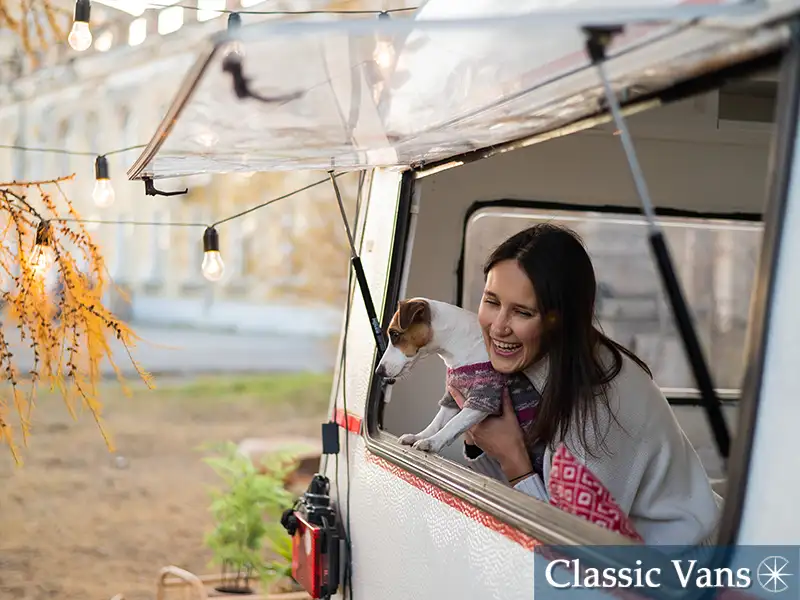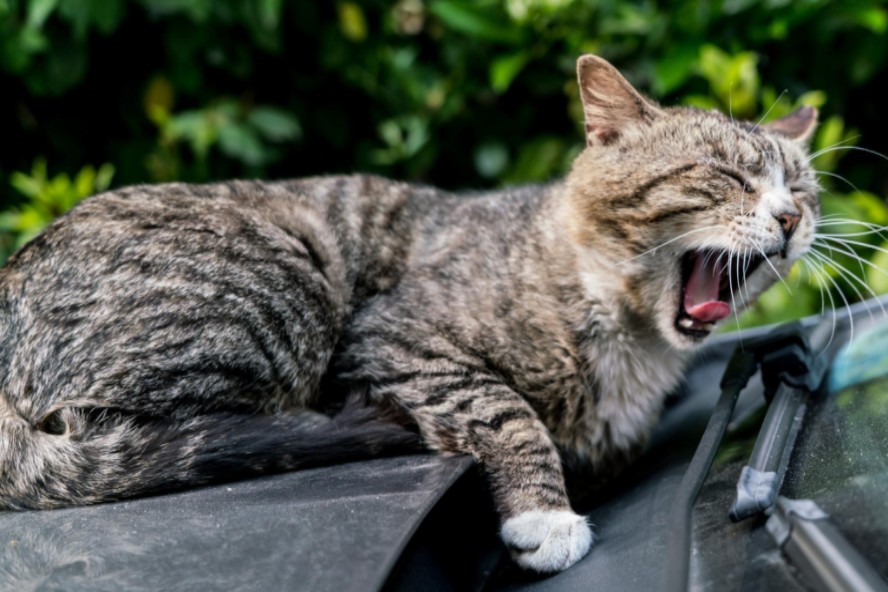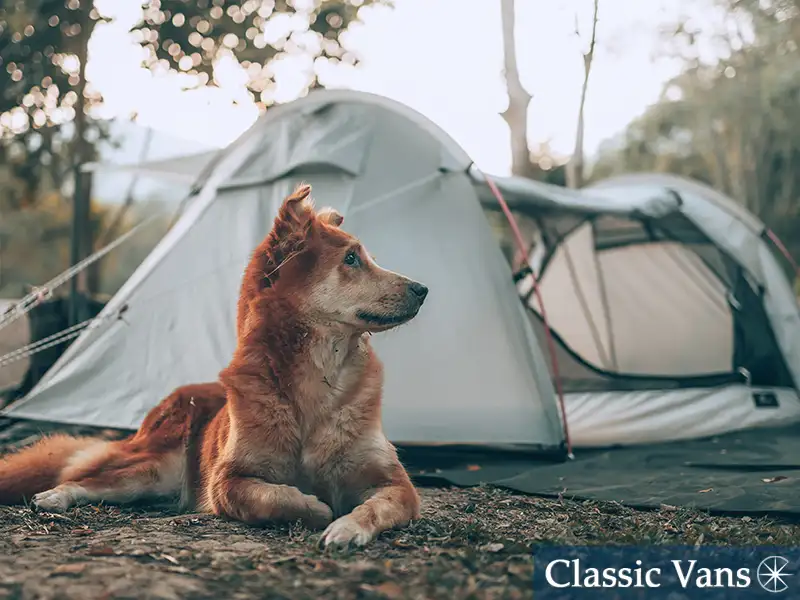Pet-friendly tips for RV and motorhome owners on how to travel safe with your furry, four-legged family members
An RV, class B motorhome or campervan is essentially your home on the road, and what better way to feel completely at home than having your favorite animal companion along for the ride? Dogs and cats can be great travel buddies depending on their individual personalities and the precautions you take beforehand to acclimate them to the vehicle.
Continue reading for some advice…
Traveling with dogs
Dogs are generally thought of as good travelers, and this seems to be confirmed by the amount of people driving around with dogs with heads hanging out the window. However, not all dogs immediately take to traveling in a moving vehicle. If you’ve never taken your dog in your car before, you will definitely want to practice before your trip.
The first thing to do is find out if your dog is prone to motion sickness. If you plan on traveling a lot, it’s also important to make sure your dog is updated on all his or her vaccinations.
Once you’ve determined your pup’s ability to handle a moving vehicle, it’s time to introduce him to the RV or motorhome while it’s parked. Let them explore the entire vehicle and get comfortable.
When you start driving the vehicle, do so slowly and consider keeping them on a leash and closeby to minimize frightened reactions. Some dogs feel more comfortable on a leash when in a strange place. Start with a few short trips around town to get your dog used to how the vehicle feels when it’s moving.
Bonus tip: To help your dog feel more comfortable in the van or RV, bring object that they’re familiar with, such as the dog bed, a few favorite toys, and some treats to reward him or her for staying calm.
When you start traveling with your dog, it’s important to stop about every three hours to give them a chance to relieve themselves and run around for a bit. This is a good time for you to stretch too. Also, try to keep the vehicle at a consistent temperature for your pet’s comfort.
Traveling with cats
Cats often have a harder time acclimating to RV and camper van life simply because they’re not always as social as dogs can be suspicious of new surroundings. Successfully taking your cat on a road trip where they feel safe and comfortable greatly depends on your cat’s personality.
As with a dog, it’s important to take your cat into the vehicle before you start driving and let them explore. Cats typically prefer to have a safe hiding space. Consider setting up their bed in a cozy corner, or put the cat carrier in the vehicle with the door open so that they can run into it if frightened. A cardboard box might also do the trick. It’s a good idea to have more than one safe hiding space for your cat.
After your cat appears comfortable when the vehicle is parked, start taking short trips around town to get them accustomed to the movement and noise of the engine and road. As with a dog, it’s important to bring familiar items that the cat likes and is familiar with, such as their bed or favorite blanket, feeding dishes, toys, treats and catnip.
Also, try to place their litter box in a quiet location. You might consider getting a covered litter box to add privacy and cut down on mess.
If your cat has claws, it’s important to keep windows and doors closed if you have screens. If you don’t have screens, keep windows and doors closes at all times. Spooked cats move quickly, and they can easily slip out and get lost if you’re not paying attention. You might consider buying a leash and harness for your cat for extra safety and so you can take it outside without fear of it running away.
Packing for your pet
You definitely want to pack the right gear for your pet, just as you would for yourself and your kids. Bring plenty of your pet’s usual food. Most dogs and cats don’t like having their food switched all of a sudden, and this can add to their stress during a trip. If you don’t think you’ll be able to find their preferred food on your route, ensure that you’ve packed an adequate supply.
Also, bring any medications that your dog or cat takes as well as grooming supplies. Some pets, especially cats, may shed more when stressed.
Even if your pet is well-trained, you never know when they might make a mess. Bring pet stain cleaner and plenty of paper towels. For dogs, you may need to pick up after them at campgrounds and RV parks, so be sure to bring extra plastic bags and a scooper for this purpose. For your cat, make sure you have enough litter to keep their box clean and odor-free. RVs and motorhomes are a small spaces, so litter box odor tends to be more of a problem than in homes.
Safety first
Safety is one of the top considerations when bringing your pet on a road trip. Consider having your pet microchipped before taking them on a long trip, just in case you two get separated. At the very least, make sure to have ID tags on them at all times. The ID tags should have your phone number on them.
Bring vet health records and proof of vaccinations as these might be necessary at certain campgrounds and parks.
For both cats and dogs, a leash is often necessary. Some camping areas may have rules that dogs need to be leashed at all times. For cats, a leash can help ensure that they don’t make an escape when you least expect it.
When the vehicle is moving, remember that it’s like any other car and your pet can get hurt in the event of an accident. For larger dogs, you might try to get them used to being buckled up on a seat. For cats and smaller dogs, consider securing them in a carrier while the vehicle is in motion. It’s never a good idea to hold pets on your lap as they can negatively affect your driving skills and be seriously injured in an accident
With enough careful planning and patience, most pets can get used to the environment of an RV or motorhome.
Looking for a pet-friendly campground for your next road trip? Check out our guide to top California campsites for dogs.
How to create a pet first aid kit for emergencies on the road
Despite your best planning and efforts, some accidents are simply unavoidable. By putting together a pet first aid kit before you travel, you can ensure the overall safety and well-being of your pet while on the road.
When creating a pet first aid kit, here are a few key items you should include:
- Clean towels
- Gauze for wrapping wounds
- A muzzle
- A digital thermometer
- Scissors
- Disposable gloves
- A flashlight
- Tweezers
- Sterile lubricating jelly
- Saline solution
It’s also always a good idea to have a list of important phone numbers, like your vet and an emergency hospital in the location where you plan to travel, so you don’t waste precious time during an emergency.
How can I help my pet with travel anxiety?
Before you head off on your road trip with your pet, you’ll also want to take steps to minimize their anxiety during travel. Here are some things to consider:
- Familiarize your pet with your motorhome by letting them explore it beforehand.
- Take short practice drives to help them acclimate to the motion.
- Create a comfortable and secure space (designated just for them) in your motorhome with their favorite toys and bedding.
- Use calming aids like pheromone sprays or calming treats.
- Try to keep the atmosphere relaxed and avoid sudden loud noises.
- Take breaks to offer reassurance and positive reinforcement.
Depending on your pet’s anxiety level during travel, you may also want to consult with your veterinarian for additional advice or medications if needed.
Tips for keeping your pet cool on the road
With high temperatures in the summer across many U.S. states, you’ll want to be sure to stay cool and comfortable when you travel. Consider the following pet-friendly travel tips to keep your pet safe from the heat:
- Plan your travel time. Schedule your road trip during cooler parts of the day, like early morning or late evening, to avoid the peak heat.
- Provide ample shade. Ensure your pet has access to shade inside the vehicle. Use sunshades or cover the windows with special UV-blocking screens.
- Ensure proper ventilation. Keep the windows cracked or use fans to promote air circulation, and avoid leaving your pet in a parked motorhome, as temperatures can skyrocket quickly.
- Keep them hydrated. Always bring plenty of fresh water and a portable travel water and food bowl for your pet to drink from during rest stops.
- Provide wet towels or cooling mats. Having damp towels or cooling mats for your pet to lie on will help them stay cool throughout the journey.
- Consider shorter travel legs. Break up the journey into shorter travel legs with frequent stops, allowing your pet to stretch their legs and cool down.
- Limit their exercise. Avoid vigorous exercise during peak heat hours. Instead, opt for shorter walks and playtime when it’s cooler outside. Also, avoid walking them on hot surfaces, like sand and concrete, so they don’t burn their paws.
- Provide ice treats. Prepare frozen treats like ice cubes with pet-friendly flavors to keep your furry friend refreshed. Also, try adding a few ice cubes to their water bowl when the weather is especially hot.
- Don’t leave your pet alone. Never leave your pet unattended in a motorhome, even for a short while. The temperature inside a parked motorhome can quickly become dangerous for their health.
- Check your accommodations. If you plan on staying at a campground, ensure they’re pet-friendly and have adequate facilities for your pet’s comfort.
What should I do when my pet needs to go potty on the road?
Portable litter boxes make it fairly easy to take care of a cat’s bathroom needs on the road. Unfortunately, when your dog has to go, it can be a bit more challenging. However, with some basic planning, you can ensure your canine friend feels comfortable and avoids accidents.
First and foremost, try to pull over and give your dog a chance to go potty at least every 2 hours, and be sure to keep them on a leash or harness. Additionally, you should always have doggie poop bags (or plastic grocery bags) with you so you can clean up after your pet, no matter where they go.
A few key places to keep an eye out for when your pet has to go include rest stops, tourist stations and parks. Most of these places have designated trash cans where you can dispose of your used doggie bag appropriately.
Safe pets lead to happy road trips for everyone
By following these pet safety tips, you can embark on your journey with the peace of mind that your furry companion is well-cared for and ready to enjoy the ride alongside you. Remember, a happy and secure pet makes for a happier and more enjoyable trip for everyone involved.
Contact us today or check out our website to view our current inventory.



